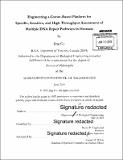| dc.contributor.advisor | Bevin P. Engelward. | en_US |
| dc.contributor.author | Ge, Jing, Ph. D. Massachusetts Institute of Technology | en_US |
| dc.contributor.other | Massachusetts Institute of Technology. Department of Biological Engineering. | en_US |
| dc.date.accessioned | 2015-09-29T19:00:30Z | |
| dc.date.available | 2015-09-29T19:00:30Z | |
| dc.date.copyright | 2015 | en_US |
| dc.date.issued | 2015 | en_US |
| dc.identifier.uri | http://hdl.handle.net/1721.1/99054 | |
| dc.description | Thesis: Ph. D., Massachusetts Institute of Technology, Department of Biological Engineering, 2015. | en_US |
| dc.description | Cataloged from PDF version of thesis. | en_US |
| dc.description | Includes bibliographical references. | en_US |
| dc.description.abstract | Human exposure to dangerous genotoxins is unavoidable, as DNA damaging agents are ubiquitous both in our environment and within our cells. The diversity in lesions induced by these agents led to the evolution of several DNA repair pathways that suppress the mutagenic and toxic effects of DNA damage. Ironically, many cancer chemotherapeutics are themselves genotoxic due to their ability to target tumor cells that are more vulnerable to DNA damage. Therefore, knowledge about DNA damage and repair is relevant to cancer prevention, susceptibility and treatment. Despite its fundamental importance, measurement of DNA damage and repair in people is far from routine, primarily due to technological obstacles. Recently, we have developed the CometChip, a novel platform for measuring DNA damage that has its basis in the well-accepted comet assay. To advance the CometChip for broader utility in screens and population studies, we further improved the platform to provide greater sensitivity, reproducibility and throughput. We then characterized the conditions of the CometChip to analyze different DNA repair pathways. We showed that the CometChip is effective for evaluating repair kinetics and for detecting deficiencies of base excision repair, nucleotide excision repair, mismatch repair, and non-homologous end-joining. The ability to assess multiple repair pathways opens door to many applications. In terms of basic research, we applied the CometChip technology to perform cross-pathway analysis of two repair proteins, Xrccl and DNA-PKcs. Results confirm known activities as well as reveal new cross-pathway functions of these proteins. In terms of clinical relevance, we used the CometChip to evaluate small molecule inhibitors of DNA repair proteins, which are potential chemotherapeutics. In terms of public health, we exploited the CometChip to learn about differences in DNA repair among individuals. We discovered that there are subpopulations of people who share similar BER characteristics and there are shared factors between BER and NER among individuals. Taken together, the CometChip platform represents a significant technological advance. From integrated analysis of repair proteins, to evaluation of clinically relevant chemicals, to studies of inter-individual variations, the CometChip has demonstrated value in uncovering new information about DNA repair in humans. | en_US |
| dc.description.statementofresponsibility | by Jing Ge. | en_US |
| dc.format.extent | 322 pages | en_US |
| dc.language.iso | eng | en_US |
| dc.publisher | Massachusetts Institute of Technology | en_US |
| dc.rights | MIT theses are protected by copyright. They may be viewed, downloaded, or printed from this source but further reproduction or distribution in any format is prohibited without written permission. | en_US |
| dc.rights.uri | http://dspace.mit.edu/handle/1721.1/7582 | en_US |
| dc.subject | Biological Engineering. | en_US |
| dc.title | Engineering a comet-based platform for specific, sensitive, and high throughput assessment of multiple DNA repair pathways in humans | en_US |
| dc.type | Thesis | en_US |
| dc.description.degree | Ph. D. | en_US |
| dc.contributor.department | Massachusetts Institute of Technology. Department of Biological Engineering | |
| dc.identifier.oclc | 921845385 | en_US |
